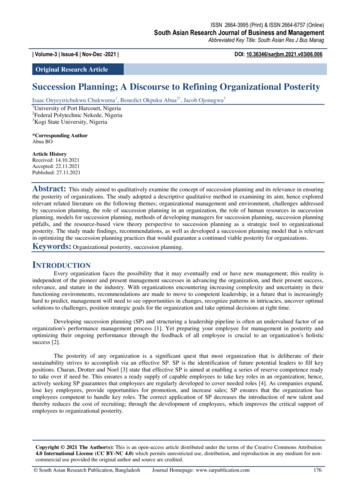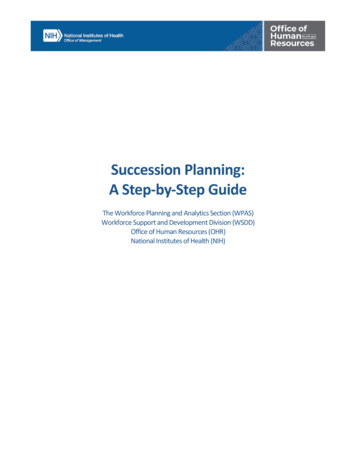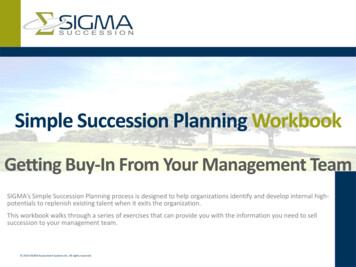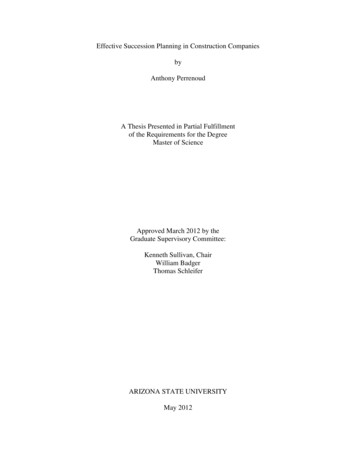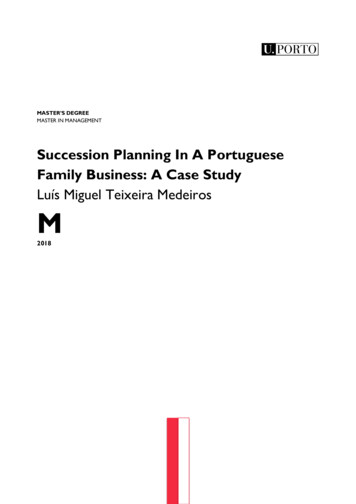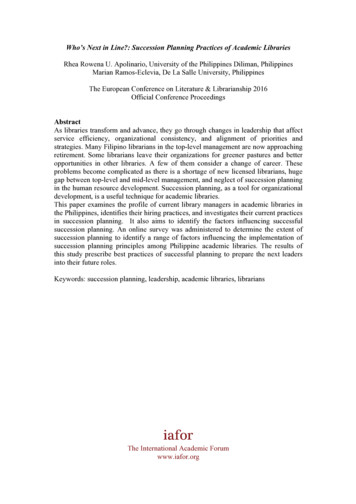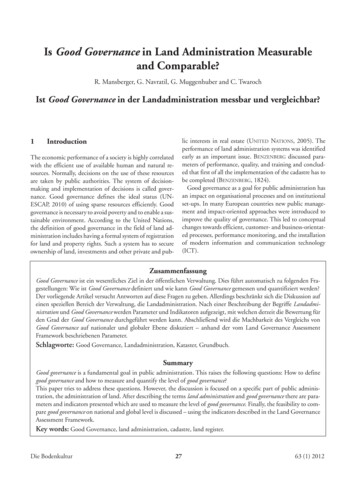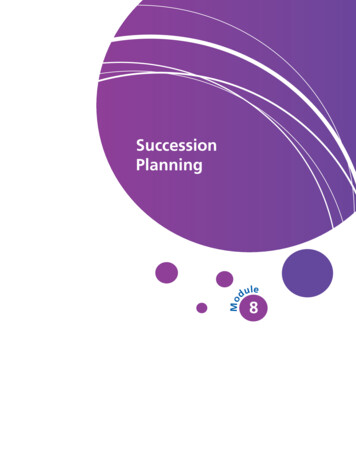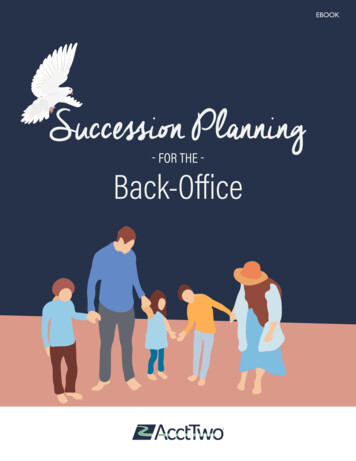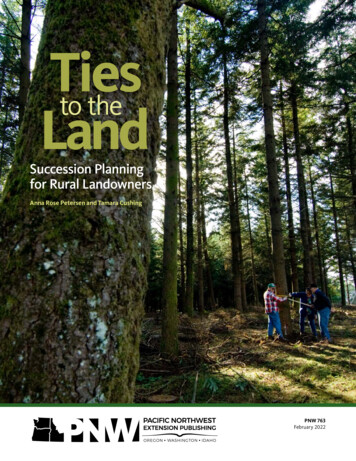
Transcription
Tiesto theLandSuccession Planningfor Rural LandownersAnna Rose Petersen and Tamara CushingPNW 763February 2022
Ties to the LandSuccession Planning for Rural LandownersAnna Rose Petersen and Tamara Cushing
This publication will be made available in an accessible format upon request. Contactpuborders@oregonstate.edu or 800-561-6719. 2022 Published and distributed in furtherance of the Acts of Congress of May 8 and June30, 1914, by the Oregon State University Extension Service, Washington State UniversityExtension, University of Idaho Extension and the U.S. Department of Agriculture cooperating.The three participating Extension services offer educational programs, activities and materialswithout discrimination on the basis of race, color, national origin, religion, sex, gender identity(including gender expression), sexual orientation, disability, age, marital status, familial/parental status,income derived from a public assistance program, political beliefs, geneticinformation, veteran’s status, reprisal or retaliation for prior civil rights activity. (Not allprohibited bases apply to all programs.)
ContentsIntroduction.7Build Ties to the Land, part 1.10Assess your financial situation.10Goals for the future.11Expand the conversation, engage the future.12Create a succession plan.18Build Ties to the Land, part 2.21Craft an estate plan.22Establish a timeline.30Worksheets.31Worksheet 1: Estimating the value of your assets.31Worksheet 2: Locating your documents.36Worksheet 3: Heirloom scale.37Worksheet 4: Vision and goals.38Worksheet 5: Planning your retirement.39Worksheet 6: Overview of management on your land or in your business. 41Worksheet 7: Meeting logistics.43Worksheet 8: Meeting agenda and minutes. 44Worksheet 9: Successor and organization assessment.46Worksheet 10: Strategies for succession.48Worksheet 11: Your team of advisors.49Worksheet 12: Legal and financial instruments.50Worksheet 13: Your succession plan timeline.52Case studies.53
AcknowledgmentsWe would like to acknowledge the authors of the previous version of Ties to the Land fortheir efforts, passion and motivation for addressing succession and estate planning for forestlandowners. The work of Clinton J. Bentz, CPA, Mark Green, Ph.D., Renee Irvin, Ph.D., ChalLandgren, Con P. Lynch, J.D., Mary Sisock, Ph.D., Susan Watkins, J.D., and Brad WithrowRobinson, Ph.D. has helped initiate succession planning efforts for small, private landownersaround the state of Oregon and the nation.The American Forest Foundation and the Oregon Forest Resources Institute were earlypartners in the effort to develop the Ties to the Land program. We acknowledge their supportfor succession planning.The Center for Family Enterprise (previously the Austin Family Business Program) at OregonState University is an ongoing partner of the Ties to the Land program, and we would like tothank them for their support.Additionally, we recognize the reviewers of this and previous editions of Ties to the Land.Many thanks to Brad Withrow-Robinson, Ph.D., John Punches, Ph.D., Glenn Ahrens, JimJohnson, Ph.D., Gilbert Shibley, Ph.D., Rick Cook, Dallas Boge, Sherri Noxel, Ph.D., AndyPerleberg, Norm Ruhoff, Dick Wittman, Chris Schnepf, and Kirk and Madeline David for theiradvice and input in this revision.Finally, a sincere thank you to all the landowners who contributed personal stories for thecase studies. You have provided an invaluable resource for others who are considering theirown succession plans and evaluating the conditions of their farms, forests and rangelands.DISCLAIMERThe information provided in this workbook and the related materials is for educationalpurposes only. If you need legal, tax, financial or other professional advice, please consult aqualified attorney, tax advisor, financial consultant or other professional.6 T I E S TO T H E L A N D
IntroductionIf you own a forest, farm, or rangeland, you probably are concerned about leaving thoselands in good shape for future generations. If you have seen a crop through to harvest,whether it is timber, corn or cattle, you have nurtured the land so that it will be productive inthe future. You care about it, and for that reason you should consider planning for the future ofyour land or associated business.When you think about planning for your land, consider the different values you associate withit. Your land’s financial value could be important, especially if you own a farm or forest enterprisethat depends on the land. Perhaps your own the land for other reasons, such as wildlife, naturalresources or scenery. Maybe you care about your home, family legacy or heritage. Regardless ofwhy you value your land, you have ties to it and are invested in its future.Since you care about the future of your land or business, it is important to develop a successionplan. A succession plan accounts for the social, financial and legal aspects of transitioning yourland or business to future owners and managers. If you have identified a successor or successorsand have gauged their interest in your land or business, plan for that transition. If you haven’tidentified any successors, consider any potential successors in your life. Finally, you may want toexplore other options to plan for the future of your land. These options can vary, from donatingyour land, selling it to a like-minded individual or organization, or entering into a conservationeasement. These situations would also call for a succession plan.Although planning for the future is important, succession planning can be a challengingand sensitive topic. It forces you to think about your death and transitioning managementof your land or business to new owners or managers. Conversations about the dispositionof your assets and the transfer of property, business and finances can be stressful. Althoughit may not be easy to plan, take the time and effort to go through the process. The result ofyour hard work will be rewarding — a plan for the future for your land, business, loved onesand new owners or managers. Many other landowners have planned for succession, and withperseverance, you too can develop a successful plan.This workbook is designed to help you through the succession planning process and providea succession planning framework — a starting point for conversing about this topic andSuccession planningforces you to think aboutuncomfortable topics.Although it may not beeasy to plan, the resultwill be rewarding.PHOTO: LYNN KETCHUM, OREGON STATE UNIVERSITYT I E S TO T H E L A N D 7
reference information about the differentoptions available. The workbook dividesthis large task into manageable sections bydescribing individual parts of the planningprocess and providing worksheets that canhelp document your planning progress. Thesuccession planning process described here isa suggestion — feel free to adapt the processto fit your needs. Build ties to the land: Begin buildingrelationships with potential successors,managers or new owners on the land sothat they understand its value and yourlegacy of stewardship.Assess your financial situation: Estimatingthe value of your assets and locating yourlegal and financial documents will helpprepare you for future conversations andplanning.Goals for the future: Establish a vision and set of goals for your land, business, retirementand planning process to clarify the desired outcome for your plan.Expand the conversation, engage the future: Expanding the conversation to others youwant to be involved in your succession plan will entail one-on-one conversations followed bylarger meetings.Create a succession plan: After you’ve gathered information about your land and assets,defined your vision and goals, and held meetings, you will begin creating your successionplan.Craft an estate plan: Consider the legal and financial documents that support yoursuccession plan with the help of your professional advisors.Establish a timeline: A timeline will help you stay on track for your succession plan andallow you to revisit your succession plan and make changes as time passes.Defining planning, successors and co-ownersBefore you begin succession planning, we want to define succession planning and providespecific definitions we’ll use throughout the workbook. Succession planning and estateplanning are closely related but are distinctly different. Succession planning considers theemotional and social aspects necessary for a smooth transfer of assets from one owner toanother and is typically intergenerational. Estate planning is a part of succession planning — itis the legal and financial details necessary for the transition of assets to occur. As you plan forsuccession, you must gather information critical for your estate plan.It is also important to define what we will call the individuals or organizations that receiveyour estate. Traditionally, an heir is associated with family, although it broadly includes anyonethe owner decides to leave their estate to. Instead, we will use successor because it denotesa wider range of individuals and can include children, nieces and nephews, neighbors, or anaspiring landowner. Although you can include organizations in your succession plan, we willnot refer to them as successors.Finally, we want to acknowledge who your co-owners may be. Depending on your situation,they may be your spouse, siblings, extended family or business partner. We will generallyaddress the idea of co-owners, so be sure to understand who they are for your situation.A word on taxesWe also want to touch on topics often associated with succession planning that may concernyou. Taxes are often the reason why landowners believe that they need to plan for the futuretransition of their property. In the past, that was true. Estate taxes were one of the largest8 T I E S TO T H E L A N DDone properly, asuccession plan willconsider your goals, yourfamily members’ needs,and the legal processfor transferring yourland or business whileconsidering taxes.PHOTO: OREGONSTATE UNIVERSITY
expenses associated with passing property on to the next generation. Now, however, federalestate taxes allow for many properties to be passed on without a large tax burden. But evenwhen taxes were high, it was possible to pass on property without a big tax bill if properplanning had been done.This brings us to the core point of this workbook: PLAN. The key to a successful transfer ofyour land is to understand the financial and emotional value of your property and to makeplans for a transfer that works for all involved. Done properly, a succession plan will consideryour goals, your family members’ needs, and the legal process for transferring your land orbusiness while considering taxes.Additionally, tax laws change fairly frequently. This makes planning for tax minimization achallenge. You should consider engaging the services of an accountant or estate tax attorney whowill help you create a plan that can be flexible enough to withstand moderate changes to the taxcodes. Taxes should never be the single factor driving how you manage or transfer your property.Rather, taxes are one piece of a puzzle that fits into your goals and vision for your land.The real cost of succession planningThe cost of succession planning depends on how much time and money you want to invest inyour plan. A successful plan usually requires consultation with legal, financial and professionaladvisors. This may be expensive, but they will ensure that you are not alone in this process. Theteam you choose will depend on your vision, goals, assets and future owners and managers.Planning early and investing in professional resources will be invaluable as you transition yourland and assets.Having a plan and communicating openly can be emotional, but not having any plan at allexacts an even higher emotional toll. Investing in professional guidance can help you avoid thatcostly heartache, however. Having a plan and communicating openly alleviates stress and keepsall parties up to date and informed. Planning also helps you, your loved ones, and future ownersand managers establish expectations about the transition so that the outcome minimizes hurt orresentful feelings after the transition. Creating a successful succession plan is not easy, but in theend, it is worth it if it means avoiding drama and emotional pain after the transition.We’ve included case studies — fellow landowner stories in the workbook. This sectioncontains stories from landowners like you sharing different strategies they employed in theirsuccession plan. Don’t be overwhelmed by the task ahead of you. You’ve got a head start byrecognizing the need to plan!Succession planninghelps you, your lovedones and futurelandowners lay outexpectations around thetransition. This keepsresentment and hurtfeelings to a minimum inthe long run.PHOTO: ANNA ROSE PETERSEN, OREGON STATE UNIVERSITYT I E S TO T H E L A N D 9
PART 1Build ties to the landAs you begin planning for succession, you may or may not know who you want tomanage or own your land or business in the future. Whether or not you know, theprocess of succession planning will help you to gain confidence in choosing who topass your assets and business on to. It helps to first develop a clear vision and goals beforeselecting successors or an organization; it can help clarify who you want to be in charge of yourland or business in the future. Having a vision and goals outlined before selecting a successoror organization also helps you identify what you value about the land or business and whatdirection you want future managers to take. Finally, understanding your wants and needs forthe future before enlisting the next generation can help you better articulate your desires andexpectations to them.If you already know who you want your successor to be, consider how you want to developtheir ties to the land or business now. However, consider your vision and goals before doingso. Keeping an open mind about potentialsuccessors and organizations will allow you tomake the best decision.Passing on your legacy will require you toconnect with successors or organizationsduring the planning processes. This canhappen at any point during the successionplanning process, so don’t worry about nothaving a clear idea of who will be the futureowners, managers or stewards right now.Going through the succession planningprocess will help you find and chose asuccessor, successors or organization thatfits into your goals and plans. When the timecomes, you will foster your successors’ orIf you have a successor in mind, consider how youorganizations’ connections to the land ormight develop their ties to the land or business now.business at the pace and time that fits yourPHOTO: LYNN KETCHUM, OREGON STATE UNIVERSITYsituation.Assess your financial situationTo build a foundation for your plan, first assess your financial situation, vision and goals. Toassess your financial situation, evaluate your assets and take a comprehensive inventory ofyour land, personal property, household items and finances. Keep in mind that your assetsinclude those you own jointly. Knowing what you have will help determine how to allocate yourassets among your successors or organizations.If you own a farm, forest or ranch enterprise, know its value. Determining the value of yourinvestments, infrastructure and equipment will be useful when you communicate your visionand goals to your potential successors or organization. It will also help your professionaladvisors understand your financial situation as they assist you in the planning process.There are two worksheets for this section. Worksheet 1 provides space for you to record aninventory of your assets. Additionally, you will determine the fair market value, or how much awilling buyer would pay a willing seller, of your items and property. Your county’s tax assessoroffice or website has adequate information on the assessed value of your land or home. Grouplower-value items together in your inventory or skip them. Take time to research, but it’s notnecessary to get a precise value. Organize this information in a manner that makes the mostsense to you. The goal is to build an inventory and estimate the value of your items. Assetvalues change over time, so update this information every five years.Worksheet 2 has space to record the location of important legal or financial documents. You1 0 T I E S TO T H E L A N DCHECKLISTPlans (check if completed)ForestFarmBusinessEstimate value(Worksheet 1)House and buildingsBank accountsSocial Security andretirement accountsProperty and landMutual fundsHousehold itemsEquipment andvehiclesInvestmentsAnnual expensesTimber, crops andlivestockLife insurance policiesLocate your estateplanning documents(Worksheet 2)
Review the differentactivities on your landand evaluate how theymight be managed.PHOTO: LYNN KETCHUM, OREGON STATE UNIVERSITYwill need them later. These documents can include bank statements, insurance policies and awill. Take notes about where they are so that you and your co-owners can find them later on.If you have a farm, business or forest management plan, you may have already collected thisinformation. If you haven’t, now is the time. Having plans will allow you to review the differentactivities on your land or in your business and evaluate their management.Set goals for the futureAs you estimate the value of your assets, begin defining your vision and goals. You may knowthe condition of your land or business, but how will you continue to manage and operate it?To determine this, work with your co-owners to create a shared vision and set goals to helpachieve it. (Note: others will be brought into the conversation later on.)A vision defines the direction you want your land or business to take. It should be a bigpicture idea of what you want to happen. It can include everything from passing on the familyfarm or forest or donating your land to a land trust to selling your land to a new owner with thesame energy and ideas. Your vision should be something you are passionate about, and youshould use it to provide direction for completing your succession plan.Setting goals, on the other hand, considers finer details of your vision and how the land orbusiness could be managed or operated in the future. Your goals should be specific, timeboundand attainable. Specific, timebound goals help hold you accountable for completing taskswhile attainable goals help you make progress on your succession plan. Your goals couldbe financial, such as increasing profit over the next five years or saving money for a child’scollege education. Alternatively, they could be management related, such as having youngergenerations in charge after ten years, introducing more vegetable variety on your farm, orthinning a stand for income and creating wildlife habitat. They might be a combination of bothfinancial and management goals, and you may have many or just a few. Regardless, your goalswill be unique to your vision, situation and needs.As you develop your vision and goals, Worksheets 3–5 will ask you to:Consider how you feel about your land or business. Outline your goals. Define your retirement and long-term care needs.All worksheets require that you communicate with your co-owners or spouse to build a strongsuccession plan. In doing so, you may find others don’t have the same feelings or goals. That’sOK, but you will need to find a compromise so you can continue planning.Worksheet 3 is called the Heirloom Scale. It helps you evaluate what the land or businessmeans to you. Examine why you selected your place on the scale and then converse with yourco-owners to understand their perspective. There is no right or wrong answer, but note thatyour place on the scale can change over time based on your age, current circumstances and lifeexperiences. T I E S TO T H E L A N D 1 1
Worksheet 4 has you state mid- and long-term goals for your landor business. You will also come up with several immediate goals andrecognize some of the challenges that could result in an undesiredoutcome or interfere with your plan. Finally, after recording yourvision and goals, you and your co-owners will need to sit down, discussthem, and come up with shared goals.Worksheet 5 considers your retirement needs and should becompleted with your spouse, if applicable. Assess your anticipatedneeds after the transition to new owners or managers. This isimportant if you rely on income from your land or business. It’sprudent to plan for long-term health care for your benefit and thefinancial benefit of your family or successors. If you are not retiredyet, consider where you want to be financially or emotionally whenyou retire. If you have already retired, this worksheet will allow you toassess your current plan or situation.Worksheets 4 and 5 provide you with starting points. Worksheet 4will help you develop goals for your land or business and prepare youto converse with those involved in your succession plan. Worksheet 5helps you collect information that your financial advisors will likely askfor later on and prepare you for those important conversations.Setting goals and having open conversations about those goals iscrucial if you operate a family business. Your goals must clearly reflectwhat you want to happen with your business when it’s transferred tothe next generation of owners or managers. Understanding what youwant to happen will help you better articulate your vision and goalswhen you bring others into the succession planning conversation.At this point in the succession planning process, you should focus onclearly developing your own goals and vision. Be confident that this is what you want to havehappen in the future. You should be prepared to discuss them candidly in the next section,Expand the conversation – engage the future. This section addresses family meetings andprovides an outline for sharing and discussing goals. You can also consider giving your childrenor successors copies of worksheets 3 and 4 so that they can develop their own set of goals andbe more prepared to have this conversation with you.CHECKLISTCompleted the Heirloom Scale and discussed it with your co-owners (Worksheet 3).Completed vision and goals. Agreed on a shared vision and goals with co-owners. (Worksheet 4).Completed retirement assessment (Worksheet 5).Expand the conversation — engage the futureAt this time, take the next step in the succession planning process by gathering informationabout others’ views of your land or business. Depending on your situation, you may includefamily members, such as children, grandchildren, nieces, nephews or cousins; friends;neighbors; business partners; aspiring landowners; or members of organizations. Regardlessof who they are, you must carefully consider if they should be involved in your plan. If youidentified potential successors or an organization, communicating with them can help avoidassumptions about future ownership and management. If you are unsure, you can exploreother options for future stewardship of your land. We suggest you engage others in two parts—first in one-on-one conversations and then in meetings.ONE-ON-ONE CONVERSATIONSHaving one-on-one conversations with others you wish to include in your plan is imperative.These informal talks will make them feel safer disclosing their feelings about their interest inthe future of your land or business. In these conversations, express an expectation for honesty,1 2 T I E S TO T H E L A N DInvolve youngergenerations inmanagement as youtransition.PHOTO: STEPHEN WARD, OREGON STATE UNIVERSITY
demonstrate active listening skills and acknowledge their concerns. Setting these expectationswill facilitate communication throughout the planning process. During these conversations,you will likely need to investigate which successors are willing to put in the work necessary tokeep your land or business operational. Finding this information out is particularly importantif you own a land-based business because of the high amount of personal investment requiredfor operation and management. There is space provided at the end of this section for you totake notes about your one-on-one conversations.If you have identified potential successors, whether they are your children or family friend, tryto hold these one-on-one conversations on your land. Explain the Heirloom Scale to them andhow they can use it to discuss their feelings about the land or business. Be honest and carefullygauge their level of interest in ownership or their willingness to take on an active managementrole in the future.Alternatively, you may not have successors or you may discover that your potential successorsare unable to take your place. There are solutions. You can expand your scope to include nieces,nephews, neighbors, etc. You could also build a relationship with an organization. Conservationorganizations, charities or universities accept land donations for a variety of reasons: ecologicalconservation, research and education, or revenue. Regardless of the organization, make sureyou know their mission, land acceptance criteria and communication style. For example, notall universities can accept land or land donated for a specific purpose. They may accept theland to sell and generate revenue. Charities may also accept land to generate revenue. Landtrusts generally accept donations of land or conservation easements. If you are considering anorganization, talk with them directly to see if they would be a good fit for your situation. Sincethey may be the next stewards of your land, it is very important to establish a good workingrelationship with them. Regardless of who your successors or organization are, you will have anopportunity to evaluate one that you talked to in the next section, Creating a succession plan.In addition to connecting with people you want to be involved in your succession plan, now isthe time to consider the current management structure and activities of your land or business.Identifying the jobs or tasks that need to be performed, the individuals you work with, andannually occurring activities allows you to paint a picture about what is necessary to manageyour land and keep an operation running smoothly. This will be important to consider as youbegin figuring out how to make the transition to the next generation successful. Worksheet 6records current management activities for your land or business by identifying who does whatand the timing of those activities. The worksheet will also ask you to brainstorm who might becapable of filling those roles in the future.Hold those importantone-on-oneconversations withsuccessors on theproperty itself.PHOTO: LYNN KETCHUM, OREGON STATE UNIVERSITYT I E S TO T H E L A N D 1 3
Consider groupdynamics when holdinga family meeting.Facilitators can help.PHOTO: NATURAL RESOURCESCONSERVATION SERVICE,CC-BY-ND 2.0HOLDING A MEETINGAfter holding one-on-one conversations, hold a meeting or series of meetings. Althoughmeetings may seem formal and intimidating, they allow you to efficiently share information,discuss your vision and goals, and incorporate others into the planning process. Thesemeetings can be held in person or remotely, depending on your needs.Prior to your first meeting, you and your spouse or co-owners should establish a set of groundrules that outline how you expect everyone to communicate. Setting these expectationswill establish a level playing field for conversation and can help facilitate constructivediscussions about succession planning. Examples for rules can be adapted from “Tips for goodcommunication” later in this section. At the first meeting, explain your vision and use theHeirloom Scale. Do not assume that everyone will understand your vision or want to carry itout. That is OK; it should fuel ongoing conversations about the future of your land or business.If you can, try to make building a successful plan everyone’s primary concern. This will helpfoster a group effort and a sense of unity in the planning process.During the succession planning process, you may need to hold several meetings. Thesemeetings may have different purposes:Discuss your vision and goals.Share business information. Hold trainings and provide education. Introduce your successors to your professional advisors. Give an update on your plan.The
Succession planning and estate planning are closely related but are distinctly different. Succession planning considers the emotional and social aspects necessary for a smooth transfer of assets from one owner to another and is typically intergenerational. Estate planning is a part of succession planning — it


